How should DeFi deal with catastrophic risks in 2020, and which echelons will rise again?
Author: Cao Yin, general manager of the Digital Renaissance Foundation Director
Source: Chain News
In the previous article, we introduced the huge hidden dangers that DeFi may face in 2020 ( Cao Yin: hidden dangers behind DeFi's prosperous ecology and 2020 outlook ). Based on this, this article introduces some measures that can effectively solve these hidden dangers, as well as some current global Projects in which these measures have been implemented step by step.
Introduce BTC into DeFi, cut off the asset transmission channel for systemic risks
If DeFi has systemic risks, the most important endogenous foundation is the asset homogeneity and protocol homogeneity of the existing DeFi ecosystem. Strictly speaking, like ETH, most of the tokens of Ethereum smart contracts are Utility Tokens. In terms of currency attributes, there is no Storage of Value function, and the value of UT is actually Depends on the value of the network served by the UT.
- Blockchain's First Legendary Story: Zhang Nansun's Virtual War and Choice
- Heavy! Ali Dharma Academy releases ten major technology trends in 2020, "scale production-level blockchain applications will enter the masses"
- After the large enterprises enter the market, can 2020 be the year of the outbreak of the blockchain?
At present, the value of the Ethereum network mainly reflects the DeFi system, so it forms an awkward paradox. The DeFi system is booming, and the value of ETH is consolidated. The higher the value of ETH, the higher the value of ETH, and the assets minted by ETH in the DeFi ecosystem. The larger the scale. However, once the trend has turned down, the DeFi system has problems, and the value of the Ethereum network will shrink. The intrinsic value of ETH and the market price will inevitably follow. The entire DeFi system ushered in Minsky moment.
 Picture: Asset prices plummeted after the arrival of Minsky, source: Hofstra University
Picture: Asset prices plummeted after the arrival of Minsky, source: Hofstra University
Therefore, the introduction of heterogeneous crypto assets is a top priority, and the most suitable target asset is BTC. There are many benefits to bringing BTC to the DeFi ecosystem :
1. BTC is digital gold, which bears the function of value storage (SoV), while ETH is UT, similar to banknotes. It is not meaningful to issue banknotes with mortgage banknotes. It is reasonable to mortgage banknotes with gold.
2. The valuation logic of BTC is very extant, and the price is more stable than ETH
3. The market value of BTC is much larger than ETH, which can bring more assets to the DeFi ecosystem and increase the depth of the market
4. Compared with erc20 assets, BTC has no correlation with ETH and will not be affected by the Ethereum black swan incident.
5. Friendly compliance. Regulators around the world, and even China's regulators have long recognized that BTC is a digital commodity, not a security.
6. In many countries, BTC has become a compliance carrier for fiat currencies to enter the crypto world. The introduction of BTC in the DeFi world is actually an indirect channel for fiat currencies to enter DeFi.
Of course, in addition to BTC, EOS, Ripple, BnB and other assets can also be tried, but there are various problems with these crypto assets. The introduction of the DeFi ecosystem may save branches and cause new challenges, so it is not currently recommended.
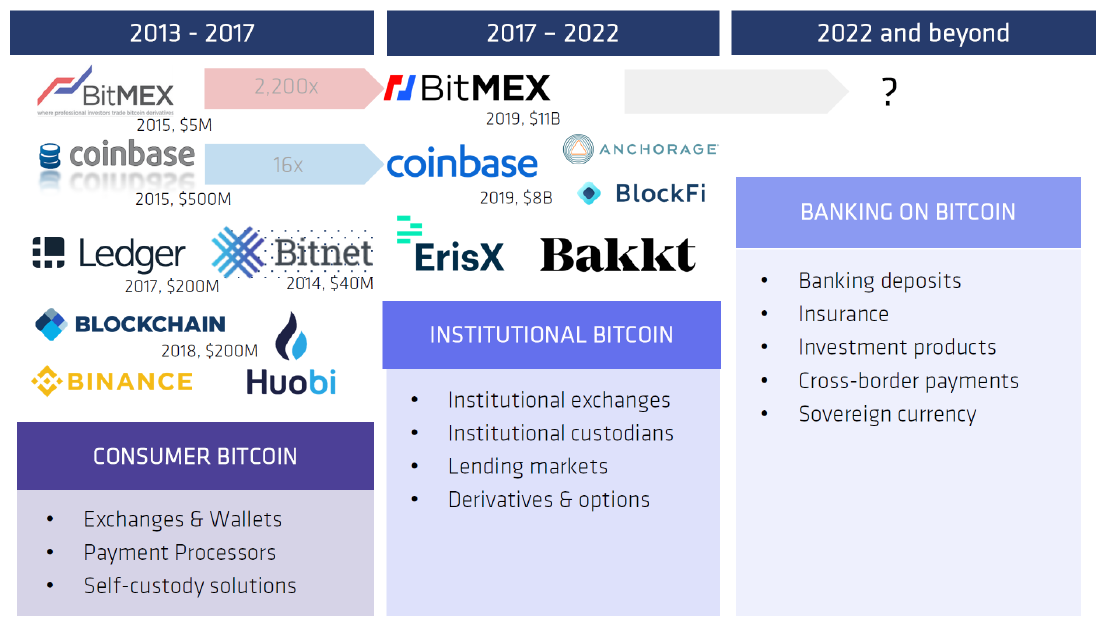 Figure: Bitcoin-based financial ecology, source: Coinshare
Figure: Bitcoin-based financial ecology, source: Coinshare
Currently, there are already some foresighted teams that have introduced BTC into the Ethereum's DeFi ecosystem, including:
1. imBTC (imtoken) 2. xBTC (ChainX) 3. tBTC 4. WBTC
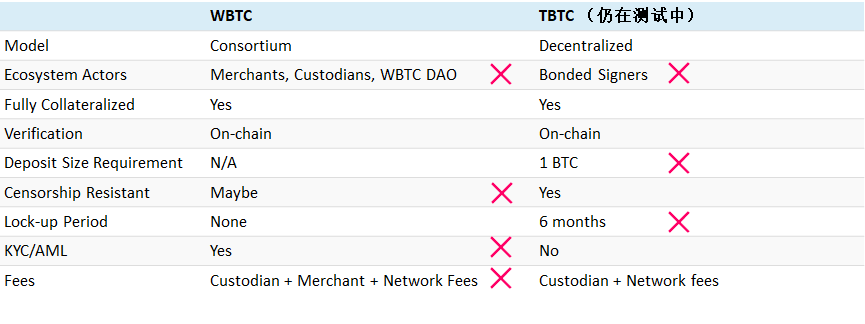 Figure: Comparison of WBTC and tBTC, source: Messari Research
Figure: Comparison of WBTC and tBTC, source: Messari Research
I prefer imBTC and xBTC to tBTC and WBTC. tBTC has just released a white paper, which is currently unavailable. The rules of WBTC are complex and KYC is required to deposit funds.
In terms of user experience, imBTC and xBTC are very simple. In addition, imBTC can be directly 1: 1 mortgage generated on imToken, holding imBTC can also share the transaction fee of Tokenlon, and can also borrow imBTC to generate interest on the DeFi lending application lendf. .
And ChainX's xBTC can not only enter the Ethereum DeFi ecological loan as an erc20 asset, but also, as a smart contract side chain of Bitcoin, xBTC provides more scenarios for the application of Bitcoin. The imagination space is particularly large and the native BTC DeFi is opened. The magical portal of the agreement.
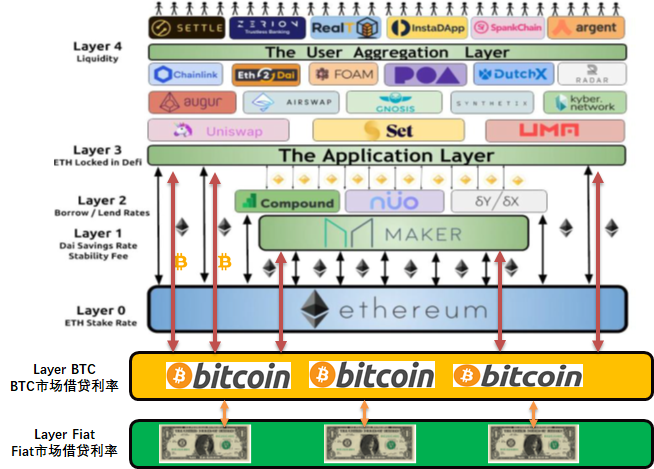
Figure: BTC and fiat currency can become important asset and protocol layers to enter DeFi, Source: Digital Renaissance Foundation
Heterogeneous DeFi cross-chain, cut off the systemic risk protocol transmission channel
BTC cross-chain into the Ethereum DeFi ecosystem, to a certain extent, it solves the current problem of DeFi asset isomorphism and cuts off the asset transmission channel of DeFi systemic risks. The next thing to cut off is the protocol transmission channel of DeFi systemic risk.
The protocol transmission channel of DeFi systemic risk is not only because of the composability of the DeFi protocol. The isomorphism of the existing DeFi protocol is also an important reason. The existing DeFi protocols are basically developed based on Ethereum. Once the Layer 1 network (Ethereum ) If there is a problem, or the commonly used Layer 2 solution, such as Rollup, Plasma, etc., problems will occur, and the DeFi protocol built on it will inevitably suffer. Therefore, a robust DeFi ecosystem requires not only the diversity of assets, but also the heterogeneity of protocols.
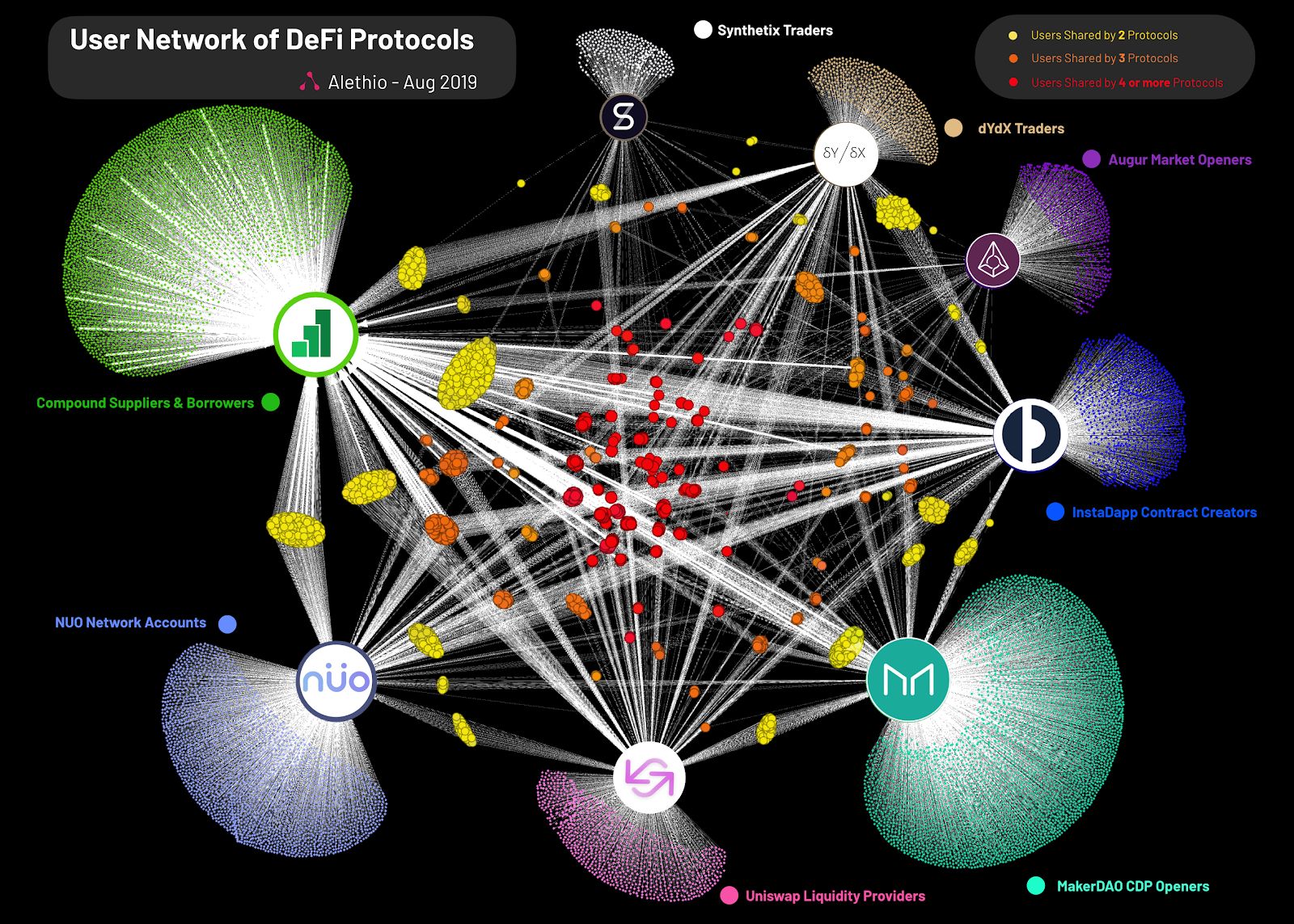
Figure: Protocol channel between Ethereum DeFi (protocol network used by users), source: Alethio
In this regard, in fact, many competing chains are trying to establish their own DeFi ecology, such as EOS, Stella, etc. The DeFi ecology based on these competitive chains is indeed heterogeneous, but there are no users. The reason for this is actually well known, there is no ecology.
Therefore, photo-isomerization is not enough, but also cross-chain. Currently it is Polkadot and Cosmos, and both Polkadot's Substrate and Cosmos' Cosmos SDK provide a native blockchain development architecture. The underlying heterogeneity and cross-chain capabilities allow Polkadot and Cosmos to have a native DeFi ecosystem like Ethereum, and DeFi assets can also flow freely between different DeFi ecosystems and protocols through cross-chain bridging.
In the Polkadot and Cosmos ecosystems, the most important basic DeFi projects are undoubtedly Acala Network and Kava. Both projects provide cross-chain stablecoins and lending services. Not only can it become an important composability module in the existing Ethereum DeFi ecosystem, but it can also become the basis of the future Polkadot and Cosmos native DeFi ecology.
 Figure: Cross-chain architecture comparison between Polkadot and Cosmos, Source: Web 3 Foundation & Cosmos
Figure: Cross-chain architecture comparison between Polkadot and Cosmos, Source: Web 3 Foundation & Cosmos
Acala is developed based on Polkadot ’s Substrate architecture, and Kava is developed based on the Cosmos SDK architecture. The current progress of the two is similar. Acala's Honzon protocol and Kava provide similar functions and provide cross-chain stable coins + lending. In addition, Acala's Homa protocol It also provides Staking asset liquidity, which will become a demand for DeFi in the future, similar to the function of bank deposit certificates.
In the future, such cross-chain DeFi projects as Acala and Kava will not only compete with the advanced technology but also with the asset ecology of the project. Acala was jointly developed by two major Polkadot ecological projects, PolkaWallet and Laminar. Among them, PolkaWallet is the first Polkadot native mobile wallet. A lot of Dots have been assembled, which can be used to generate stable coins across the chain on Acala, and Laminar provides a very valuable synthetic asset application scenario for Acala's stable currency assets, and Laminar also opens up the European legal currency deposit channel for future legal currency. You can enter Acala's cross-chain DeFi ecosystem directly through Laminar. Not only that, ChainX, an important partner of Acala, is ready to bring BTC assets into DeFi through Acala cross-chain.
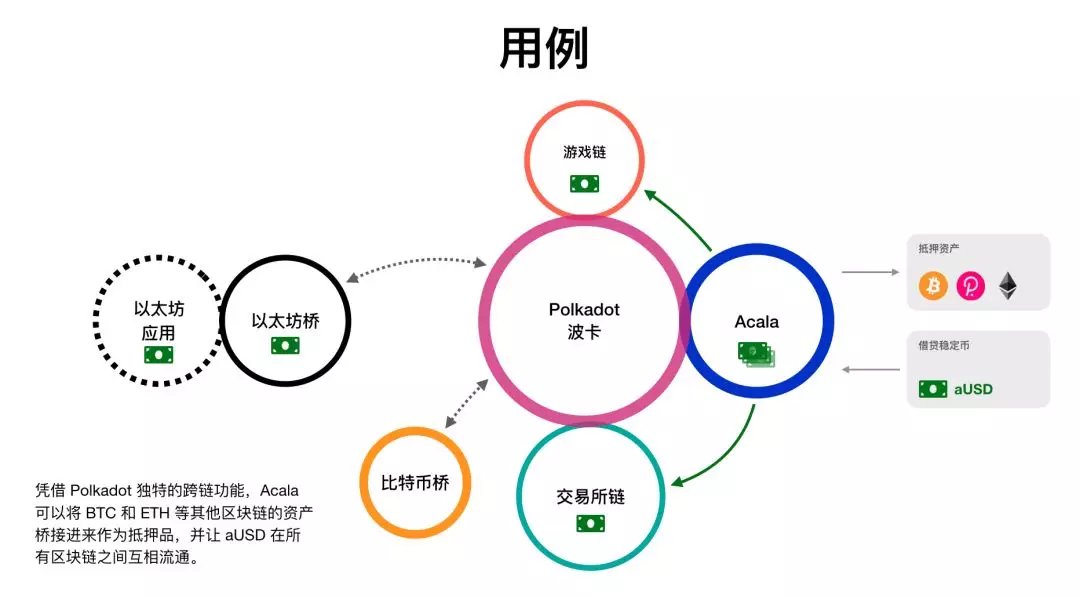 Figure: Acala's DeFi cross-chain use case on the Poca Network, source: Acala Network
Figure: Acala's DeFi cross-chain use case on the Poca Network, source: Acala Network
At present, in the cross-chain DeFi ecology, Acala and Kava are standing on the same starting line, waiting for the starting gun, but from the perspective of equipment and ecology, Acala seems to be better than Kava.
In summary, by introducing the value heterogeneous asset BTC and the heterogeneous cross-chain DeFi protocol, we can effectively cut off the systemic risk asset transmission channel and protocol transmission channel that threaten the entire DeFi ecosystem.
The financial turmoil that broke out on Wall Street in 2008 did not immediately spread to China, but caused a major blow to London's financial system. The reason is that London has greater risk exposure to Wall Street. The assets of London's financial institutions and Wall Street are homogeneous. And in terms of system and structure, London and New York are homogeneous systems. China is not the same. It has a different system and structure from New York and a capital control firewall from the outside world financial system. Therefore, the financial turmoil did not directly affect China's financial system, but indirectly affected China through economic and trade and monetary policy after the United States, making China the engine of global recovery after the 2008 financial crisis.
DeFi integrates into the real economy, self-hematopoiesis and the challenge of involution
In addition to the inherent systemic risks of DeFi, the longer-term and essential issues of DeFi need to be considered. At present, DeFi has a very serious tendency of involution. Users are mainly speculators. Many uses of DeFi are to increase leverage to speculate in coins, or even bet on contract derivatives. They have no ability to make blood.
If DeFi can only be used as a speculative tool, the funds in DeFi are likely to swell quickly, and then disappear quickly as most people gradually open positions. The crisis path is like the 97 Southeast Asian countries in the Asian financial crisis. The hot influx of foreign capital has been pouring in, raising asset prices, sharing capital dividends, raising asset prices to unreasonable levels, creating a large amount of debt, gradually selling assets to flee, letting follow-up funds take over, and then foreign investors short-handed. The entire country's financial system Destroyed instantly.
In addition, the DeFi ecology mainly for speculative purposes can be easily used by people with ulterior motives, and it has evolved into fraud and pyramid schemes under the guise of DeFi, attracting supervision and punches across the board, and dragging the entire DeFi ecosystem into the water.
Finance is a channel for capital to accumulate and circulate across time and groups. It is a lever for amplifying productivity. In order to avoid DeFi becoming a zero-sum game of involution and foaming, DeFi financial instruments must be used in the real economy. The two ends of the pipeline can be connected to the living water of the real economy, instead of the speculative standing water in the small currency circle pond, so that the DeFi ecology has the ability to self-blood and transfusion.
It is gratifying that Maker, as the cornerstone of the DeFi ecosystem, has been committed to importing assets from the real economy into the DeFi system, and has long proposed to import assets such as bonds and stocks into the crypto world. The latest MCD (multiple mortgage) upgrade is an important step towards serving the real economy.
In MCD, Maker introduced BAT (Basic Attention Token) as the collateral asset. BAT is the item closest to the real economy among MCD candidate assets . BAT is a reward for users to watch ads in the Brave browser, which can be used to reward the Brave browser. The content creators on the platform are very closely integrated with the real economy. Each BAT token is a condensation of the user's attention resources. In the Internet era where traffic is the means of production, BAT tokens have a solid intrinsic value.
 Figure: BAT's token circulation model, source: Brave
Figure: BAT's token circulation model, source: Brave
Today, the Brave browser has 8 million monthly users. Under the economic incentive of BAT, the user click-through rate of advertisements in the Brave browser reached 14%, far exceeding the industry average of 2%. In addition, there are more than 290,000 verified content creators on the Brave platform, which is still a result achieved during the exploration period.
In addition to introducing BAT on the asset side, Maker has also been exploring the application of Dai in the real economy, and cooperated with the Boca ecological project Centrifuge, so that real economy companies can use Dai to make receivables financing on the Centrifuge chain.
The Dipole Tech team in Asia is also actively exploring the field of DeFi serving the real economy. Dipole is deploying a community point-to-point electricity sales system in Manila, Philippines. The goal is to allow consumers in the community to directly purchase solar energy from surrounding rooftops. Electricity, and provides electricity consumers and producers with a retail electricity aggregation agreement on the blockchain, which greatly reduces the cost of solar power with high volatility.
 Figure: Dipole's Blockchain Power Selling App interface, Source: Dipole Tech
Figure: Dipole's Blockchain Power Selling App interface, Source: Dipole Tech
Based on the Manila project, Dipole is actively introducing stablecoins including Dai into the electricity payment link, and packaging consumers' electricity bills into digital bonds, which are then sent to the stablecoin platform as mortgage assets to provide micro-community power producers Supply chain financing services based on electricity fee cash flow. Of course, borrowers also get stable coins like Dai. After that, electricity consumers can directly buy Dai from producers to pay electricity bills. In this way, Dipole has created a DeFi tool that Dai can perfectly cycle in the actual production and consumption scenarios. In addition, the Dipole team completed the hardware development of the blockchain electricity meter, and solved the DeFi problem of the data on-chain predictor and the controllability of credit assets.
 Figure: Dipole DeFi architecture design, source: Dipole Tech
Figure: Dipole DeFi architecture design, source: Dipole Tech
The exploration of Dipole and Centrifuge has great significance for DeFi and the real economy. The significance for DeFi is that they have introduced the stable cash flow of the real economy for DeFi, docked DeFi into a productive scenario, and the capital in DeFi can be reasonable. Value-added, DeFi is no longer a zero-sum inclusive game, and has a hematopoietic ability. In addition, Dipole's software and hardware combination technology solution has relatively high control over physical assets. Under conditions that permit, it can achieve equal mortgages. Even the lack of mortgages has really served the financial purpose of creating credit.
For the real economy, Dipole and Centrifuge serve small businesses and even non-enterprise individual owners. DeFi has greatly reduced the financing costs of these operating entities. And like Southeast Asia, which Dipole mainly serves, many people don't even have bank accounts. DeFi provides basic financial services for local owners, and DeFi has the function of blood transfusion for the real economy.

Figure: DeFi links the real economy and financial resources, source: Digital Renaissance Foundation
Conclusion
In 2019, we witnessed the Cambrian explosion of the DeFi ecosystem. Various DeFi applications have sprung up and quickly occupied various niche positions on the financial protocol stack. However, the current DeFi ecosystem has serious hidden dangers of systemic risks. The endogenous foundation behind it is exactly the main driving force of the rapid development of DeFi now, the so-called profit and loss.
Moreover, the current DeFi developers are just crossing the river by feeling the stones. In the long history of financial history, there is no scheme that can be referred to. Therefore, the DeFi scheme designed by developers is unavoidable. What's more terrible is that the various types of infrastructure that DeFi builds on: the Ethereum blockchain itself is not perfect. It is in a critical period of upgrading and transformation. To put it bluntly, now the DeFi protocol ecology is like building on the beach. The more complex the castle, the more dangerous it is.
But this is not a complete negation of DeFi. DeFi has a huge demand in the encrypted financial world, and the real economic demand outside the crypto world is also emerging. More importantly, when the wealth of the ten richest people in the world exceeds the sum of the GDP of many countries, when billions of people in the world cannot enjoy basic financial services, when the world ’s policies are formulated When the user repeatedly repeats mistakes, being able to enter and exit without thresholds, low-cost services, transparent processes, and automatic DeFi financial services is of irreplaceable significance to human society.
Therefore, in 2020, DeFi developers and researchers should be down-to-earth and look up at the starry sky. They need to start from a product perspective, discover the needs, develop products, and serve users. Look at DeFi from a different perspective, take possible systemic risks seriously, and take DeFi to a higher level in the process of solving systemic challenges.
Our Digital Renaissance Foundation will also work with the DeFi project owners we have invested to incubate, play the role of thinkers behind the DeFi project parties, grow with the entire ecosystem, and work together to take DeFi from the current state of online mega open financial games To create a new financial industry that truly serves the community, so that DeFi can have the ability to create and transfusion blood.
We will continue to update Blocking; if you have any questions or suggestions, please contact us!
Was this article helpful?
93 out of 132 found this helpful
Related articles
- Hello 2020! 15 industry v have made New Year's wishes
- Bitcoin becomes the most profitable asset in 2019, and Chinese real estate is rarely a loss-making asset
- Looking at the 2019 blockchain from the industrial and commercial information: the number of registrations dropped by 20% from the previous month. Many state-owned enterprises and listed companies incorporated the blockchain into their business scope.
- Bitcoin researchers: four advantages to help Bitcoin kill altcoins
- Bitcoin: a digital transformation of hard currency
- Shenzhen cracks down on capital markets: industrial chain collapses, traders trade in exile in Southeast Asia
- Babbitt Column | The Biggest Obstacle to Blockchain Application is the Guiding Idea




